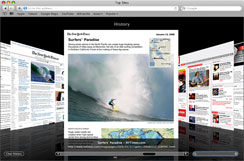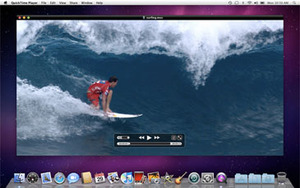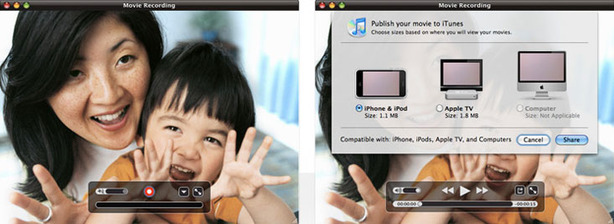
Updated Software: Safari 4.0 & QuickTime X
Safari is now at version 4.0 and is available for Leopard, Tiger, Windows XP and Windows Vista - it'll also ship with Snow Leopard in a slightly enhanced form. There are a full list of features on Apple's website and they include things such as Top Sites and Full History Search with Cover Flow - there's also a focus on speed, too, as the JavaScript engine has been heavily optimised.This is what Serlet focused most of his time talking about Safari on, which he claimed was up to 7.8 times faster than Internet Explorer 8 when running a JavaScript browser benchmark. He also added that Safari passes the Acid3 test with 100 per cent, while Internet Explorer 8 scores just 21 per cent. It's worth noting that both Chrome and Firefox also score highly in Acid3.
Top Sites has some interesting innovations, as it not only tracks which sites you visit the most, but it also checks if there are any updates on those sites. It denotes this by adding a small blue star to the right hand corner of the preview - simple, but incredibly useful in our opinion.
We're not too sure about Full History Search with Cover Flow though because it seems a little complex - most of us in the bit-tech HQ remember websites by name and not by what they looked like. However, what will make it useful is that you can search not only for URLs and keywords, but also for text on the webpages using a Spotlight search - in that instance, it could be useful when trying to find that site you visited for the first time and couldn't remember its name but do remember its contents.
The Snow Leopard version of Safari 4 will add enhanced crash resistance, as it would be able to isolate plug-in failures without crashing either the browser or the operating system. Serlet also claimed that, because Snow Leopard is only available in an x86-64 flavour (older PowerPC-based machines are not supported at all for the first time), JavaScript performance would improve by another 50 per cent on Snow Leopard - this is thanks to x86-64 specific optimisations, he said.
QuickTime, now called QuickTime X, has been given a massive interface overhaul and there are now features formerly only available in the paid-for QuickTime Pro. The brushed looks are out and instead there is a floating, translucent set of controls similar to those you'll use if you play videos directly from iTunes - you roll over to make it appear and move away and it disappears.
In addition to the new interface, Apple has included support for hardware acceleration - HD video will now be accelerated by the Nvidia GPUs included in all of today's shipping Macs. There's also simple video trimming capabilities - just drag to select the section of a video you want to export to iTunes so that you can sync with your iPhone, iPod, Apple TV or publish to MobileMe or YouTube. Finally, Apple has also added support for Apple's ColorSync technology for improved colour accuracy - this has been a part of OS X for a long time, but until now it hasn't been utilised by QuickTime.

MSI MPG Velox 100R Chassis Review
October 14 2021 | 15:04














Want to comment? Please log in.